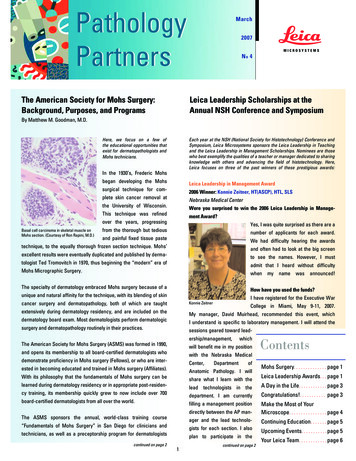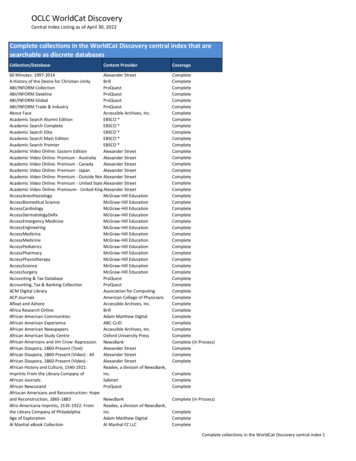
Transcription
March2007No 4The American Society for Mohs Surgery:Background, Purposes, and ProgramsLeica Leadership Scholarships at theAnnual NSH Conference and SymposiumBy Matthew M. Goodman, M.D.Here, we focus on a few ofthe educational opportunities thatexist for dermatopathologists andMohs technicians.Each year at the NSH (National Society for Histotechnology) Conference andSymposium, Leica Microsystems sponsors the Leica Leadership in Teachingand the Leica Leadership in Management Scholarships. Nominees are thosewho best exemplify the qualities of a teacher or manager dedicated to sharingknowledge with others and advancing the field of histotechnology. Here,Leica focuses on three of the past winners of these prestigious awards:In the 1930’s, Frederic Mohsbegan developing the MohsLeica Leadership in Management Awardsurgical technique for com-2006 Winner: Konnie Zeitner, HT(ASCP), HTL, SLSplete skin cancer removal atNebraska Medical Centerthe University of Wisconsin.Were you surprised to win the 2006 Leica Leadership in Manage-This technique was refinedment Award?over the years, progressingYes, I was quite surprised as there are afrom the thorough but tediousnumber of applicants for each award.and painful fixed tissue pasteWe had difficulty hearing the awardstechnique, to the equally thorough frozen section technique. Mohs’and often had to look at the big screenexcellent results were eventually duplicated and published by derma-to see the names. However, I musttologist Ted Tromovitch in 1970, thus beginning the “modern” era ofadmit that I heard without difficultyMohs Micrographic Surgery.whenThe specialty of dermatology embraced Mohs surgery because of aHow have you used the funds?Basal cell carcinoma in skeletal muscle onMohs section. (Courtesy of Ron Rapini, M.D.)unique and natural affinity for the technique, with its blending of skinmynamewasannounced!I have registered for the Executive Warcancer surgery and dermatopathology, both of which are taughtKonnie ZeitnerCollege in Miami, May 9-11, 2007.extensively during dermatology residency, and are included on theMy manager, David Muirhead, recommended this event, whichdermatology board exam. Most dermatologists perform dermatologicI understand is specific to laboratory management. I will attend thesurgery and dermatopathology routinely in their practices.sessions geared toward leadership/management,whichContentsThe American Society for Mohs Surgery (ASMS) was formed in 1990,will benefit me in my positionand opens its membership to all board-certified dermatologists whowith the Nebraska Medicaldemonstrate proficiency in Mohs surgery (Fellows), or who are inter-Center,ested in becoming educated and trained in Mohs surgery (Affiliates).Anatomic Pathology. I willWith its philosophy that the fundamentals of Mohs surgery can beshare what I learn with thelearned during dermatology residency or in appropriate post-residen-lead technologists in theA Day in the Life. . . . . . . . . . . . page 3cy training, its membership quickly grew to now include over 700department. I am currentlyCongratulations!. . . . . . . . . . . page 3board-certified dermatologists from all over the world.filling a management positiondirectly between the AP man-Make the Most of YourMicroscope. . . . . . . . . . . . . . . . page 4The ASMS sponsors the annual, world-class training courseager and the lead technolo-“Fundamentals of Mohs Surgery” in San Diego for clinicians andContinuing Education. . . . . . . page 5gists for each section. I alsotechnicians, as well as a preceptorship program for dermatologistsUpcoming Events. . . . . . . . . . . page 5plan to participate in thecontinued on page 21Departmentofcontinued on page 2Mohs Surgery. . . . . . . . . . . . . . page 1Leica Leadership Awards. . . page 1Your Leica Team. . . . . . . . . . . . page 6
Mohs SurgeryLeica Leadership Scholarshipscontinued from page 1continued from page 1interested in additional observation and training in Mohs surgery.American Management Association’s Certificate of Achievement inIn addition, the ASMS conducts a unique, annual Peer Review ofLeadership Excellence program.Cases and Quality Assurance program for its members, which consists of reviews of actual Mohs cases with accompanying glassHave you won other awards through NSH?slides, patient maps, and operative reports. This review helps assureYes. I was awarded the Miles Education scholarship in 1990 and usedadequacy and accuracy of histopathology methods, staining, marginthe funds to attend Dr. Jules Elias’ Immunohistochemistry Session incontrol, interpretation, clinical indications, and proficiency. Also, anSan Francisco. I also received the NSH Foreign Travel Scholarship inannual Clinical Symposium on Mohs surgery and related cutaneous2003, which I used to travel to Leeds, England and Edinburgh,oncology topics is held.Scotland for training. This was a great benefit to a histotech who isfascinated by neurohistology and Prion diseases.The ASMS strongly supports the highest standards of patient carerelating to Mohs surgery, promotes the benefits of ongoingWould you recommend someone for the award in the future?professional education of its members, and continues to provideYes. I am a big advocate of the scholarships offered through NSH.information for public education relating to the benefits of thisI encourage histology professionals to apply for them and believevaluable technique.that many people meet the requirements. We should take everyopportunity to further our education by applying for the scholarships. The next Annual Clinical Symposium of the ASMS, entitledI use myself as an example: I’m a charter member of NSH, and since“Dermatologic Surgery: Focus on Skin Cancer,” will be heldthese awards became available, I have received three of them. Eachin Albuquerque, NM, May 25-27, 2007.has made a major contribution toward my education. The next “Fundamentals of Mohs Surgery” course inSan Diego, CA will be held November 8–11, 2007.Do you have any comments regarding the field of histotechnology?Histotechnology has always been an interesting career field; increas-For information on these meetings, please contact:Novella RodgersAmerican Society for Mohs SurgeryBox 3915901 Warner AvenueHuntington Beach, CA 92649-4659Phone: 714-379-6262 or 800-616-ASMS (ext. 2767)Fax: 714-379-6272email: info@mohssurgery.orgingly so since 25 years ago when we moved from histochemicalstains to immunohistochemical testing. Now, with the advent of molecular pathology we have taken another big step forward. Combinethis with image analysis, and I believe histotechnology is one of thefastest changing, most exciting laboratory sciences. And we are stilla “hands on” technology where technologists can have the satisfaction of creating a beautiful end product. Leica Leadership in Management Award2005 Winner: Ethel Macrea, HT (ASCP)Ventana Medical SystemsWere you surprised to win the 2005 Leica Leadership in Management Award?Yes, shocked is more like it. I never had a clue that I was even nominated for such an honor. Being nominated and then receiving theaward is very humbling.How have you used the funds?I have mostly used the funds for text books and an occasionalseminar. I just started up a new lab so having such a windfall reallyhelps to get the tools I need to get things in order. Also, since Iteach a histotechnology program, I have used the funds for texts tosupplement the program on topics such as autopsy technique, booklets for the students. I willforensics, IHC, and self assessment2continued on page 6
A Day in the LifeMohs SurgeryBy Barbara Beck, HT (ASCP), Mohs Technical ConsultantConsultant Barbara Beck, board certified ASCPof the Mohs technician is crucial to accurate diagnosis. Diagnosis isRegistered Histology Technologist and head ofonly as good as the slide that the technician prepares, so Mohsthe Mohs Technical Consulting Company, pro-technicians carry a heavy responsibility and training is crucial.vides extensive technical assistance to MohsBeck serves asBefore leaving a client, I make sure that the lab can meet currentVice President of ASMH (American Society forlaboratory regulations for OSHA and CLIA inspections, includingMohs Histotechnology) and is the lead instruc-temperature charts and quality control procedures. I prepare atorConsultingcomplete checklist to pass inspections with zero deficiencies and aAdvanced Training Workshop. Beck worked in aprocedure manual programmed specifically for them. I am usually onMohs surgery private practice from 1987 to 2001the road every other week and currently employ three people whoand was an instructor for the School of Histotechnology, 1999-2001,also perform on-site training. I am in the process of hiring a fourthand at the University of Indiana, 1998-2001.person right now.I have been a registered, certified histotechnician since 1972. WhileMohs surgery is a growing field. My company and others like it fulfillworking as a histology supervisor in a hospital, I learned of a Mohsa growing need in the dermatology community, and we are extremelysurgeon that was looking for a part-time technician. I was hired andbusy!Surgeons and their staffs.Barbara BeckfortheMohsTechnicalworked in this private Mohs practice for fifteen years. During my employment, the doctor allowed other technicians to visit the office,and I trained them on specimen preparation techniques.Congratulations!When my family moved to the mountains of Highlands, NorthCarolina, I thought about my next career move and decided to start aconsulting firm for existing and start-up Mohs surgery practices.Leica conducted a direct mail promotional program in 2006 to high-Now, I travel the country providing extensive, hands-on training andlight Leica’s DM Series of ergonomically designed microscopes fortechnical support to Mohs surgeons and their staffs.clinical pathology laboratories.Winner of the Serious Comfort DM3000 Drawing and recipient of aA typical training week begins when I arrive at the dermatology officeLeica digital camera:on a Monday afternoon. I get to know the staff and prepare them withDr. Mark Best, LECOMan overview. Sometimes I arrive at the office and the cryostat has notyet been unpacked.Winner of the Designed for Your Comfort DM1000 Drawing andWe cross-train medical assistants, nurses,recipient of a Herman Miller ergonomic chair:and registered histotechnicians. And often, I train technicians withBonnie Pringle, Oswego Hospitallittle or no experience. Mohs surgery is different from routinehistopathology. The whole idea behind Mohs is to remove only abnor-Thank you to everyone who participated in Leica’s 2006 promotionalmal tissue and save as much healthy tissue as possible. There is anprograms. To add your name to our promotional mailing list, emailart to preparing specimens, and the procedures for Mohs arepathologypartners@leica-microsystems.com and type PROMOTIONextremely precise and detail-oriented.in the subject box. During the remainder of the week I conduct hands-on training as thesurgeon simultaneously performs live Mohs cases in the office.The new Mohs technicians learn how to process tissue samples,orient specimens, and prepare slides for viewing under the microscope. I prepare the first several slides while the surgeon and staffobserve. As the cases continue throughout the week, the staff beginsto prepare specimens under my supervision. The art and precision3
Make the Most of Your MicroscopeDigital Imaging Part 2– Calibration and Digital MeasurementBy Rob Kimura, Leica Product Manager, Digital ImagingImage measurement is the discipline of taking quantitative data fromdistance. From here the user simply selects the unit of measurementan image, for the purpose of documentation and analysis. In the lastthey would like to calibrate for (µm, mm, inch, etc.). The system isissue of Pathology Partners, we discussed the process of manuallynow ready to auto-calibrate acquired images to measure.calibrating a microscope and digital camera for measurement.However, new advancements in automated microscopy, computerThe benefit of automated calibration is that the user simply selects ansoftware control, and digital cameras offer a faster and more accu-acquired image and the correct calibration is set for doing measure-rate way of calibrating your measurements.ments. Then measurements (linear, area, angle, diameter, multi-line)are taken by clicking on the computer screen. As the measurementsFactors to consider when calculating proper magnification for analy-are completed, final measurement results are displayed.sis and documentation include eyepiece magnification, cameraadapter, digital camera sensor size, objective magnification, andinternal magnification changer. Automated microscope systemsbridge traditional optical design with electronic encoding andcomputer control capability linked to an internal database. This database comprises magnification and numerical aperture information foreach objective. As the user changes objectives, the microscope’sinternal processor can automatically detect the change and determine what type of new objective is now in the optical plane.Automated microscopes that incorporate an internal magnificationcharger can detect which magnifying lens has been inserted into theoptical plane. These software-controlled systems often include anautomated and manual control for changing magnifying lenses.There are many camera choices that integrate with an automatedmicroscope. Some are used with software that can auto-detect chipAutomated laboratory microscopesize and individual pixel size within the camera housing. Automated microscope components such as the camera adapter andeyepieces that are not automated or encoded for automated identification, have fixed magnifications that the user does not normallychange. The user can simply input these magnifications and the software automatically calculates the correct calibration of the systemas it is configured.Formula:Eyepiece Mag. x Objective Mag. x Mag. Changer x Camera AdapterMag. Total MagnificationExample:10x Eyepieces x 4x Objective x 2x Mag. Changer x .5x CameraAdapter 40x Total MagnificationBy the camera chip size, we know the camera’s field of view tocalculate how many pixels on a computer screen equal a particular4
The Importance of Continuing EducationBy Barbara Beck, HT (ASCP), Mohs Technical ConsultantThe ASMH (American Society of Mohs Histotechnology) is affiliatedContinuing education greatly impacts your professional career. Andwith the American College of Mohs Micrographic Surgery andeffective, efficient communication is critical to career advancement.Cutaneous Oncology. The ASMH annual meetings include manyAttending workshops and continuing education courses makes youinformative hands-on sessions. The workshops cover cryostatmore valuable to your employer. When your employer knows you aresectioning, but allow technicians to troubleshoot and gain furtherlearning more about your field, you become an asset to them, andknowledge on all aspects of Mohs technology. The workshops alsoyour knowledge improves patient care. I encourage you to be activeinclude hands-on staining techniques and provide a wonderfulin your professional society. Your society is a forum for you and youropportunity for technicians to get answers for basic problems thatcolleagues from across the country to meet, share experiences, andcan occur any day in a routine Mohs laboratory.brainstorm solutions to take back to the lab. Who knows, maybe youare the next histo guru! Upcoming EventsVisit Leica at the following exhibitions:USCAPMarch 26-28, 2007San Diego Convention Center,Booth #624ASCT Annual MeetingApril 27-29, 2006San Antonio’s Sheraton Gunter Hotel, Booth #12Hands-on workshop. Courtesy of Mohs Technical Consulting.ASDS ACMMSCOMay 3-7, 2007Naples Grande Resort & Club, Naples, FLIt is imperative for all Mohs technicians and histology technicians tokeep their skills as sharp as possible, not only in the Mohs lab, butTo find additional exhibitions Leica will attend, visit:www.leica-microsystems.us and click Companyalso in the histopathology lab. These skills prove valuable with oldand new technology. For example, several Mohs laboratories nowEvents.implement immuno procedures for diagnosing melanomas. TheseComing soon to a hospital near you!immuno stains require complete, thin sections, which are not alwayseasy to prepare. Beginner technicians can pick up helpful hints fromLeica’s 2007 Summer Seminar Seriesexperienced technicians that perform immuno staining techniques.Earn CEU credits Network with colleagues See Leica’ssolutions to the safety, ergonomic, and automation challenges inI enjoy sharing skills and tech-your lab! Email pathologypartners@leica-microsystems.com forniques. It helps me to remembermore information!why I chose this profession and renews my enthusiasm for thework. It is great to teach thehands-on workshops and seedelight on the faces of newertechnicians when they learn aneasier technique. Any time wesimplify our work environment, itHands-on workshop. Courtesy of MohsTechnical Consulting.benefits the medical staff, and isa huge asset to the patient.Experienced technicians also benefit from exchanging expertiseno matter how long we have been working in the field. We canalways pick up techniques and hints from networking with otherexperienced techs at meetings like the ASMH.5
Leica Leadership Scholarshipscontinued from page 2edge considerably. I recently obtained my Specialist in Laboratoryforensics, IHC, and self assessment booklets for the students. I willSafety from the American Society of Clinical Pathology, and I am nowprobably apply whatever is left toward my trip to NSH in the fall.pursuing my Chemical Hygiene Officer certification through the National Registry of Certified Chemists.Have you won other awards through NSH?Yes, I have been very blessed. I won the Dezna Sheehan awardI used part of the funds to buy histology textbooks to teach my tech-several years ago as well as a few on the state level.nologists and help them study for the ASCP Histology TechnicianWould you recommend someone for the award in the future?board examination. In addition, I give workshops and lectures atAbsolutely. There are many fine histotechs out there and a littlestate and regional meetings, often referencing the textbooks.acknowledgement goes a long way.Do you have any comments regarding the field of histotechnology?Do you have any comments regarding the field of histotechnology?I truly believe that histotechnology is at a crossroads. We as profes-First and foremost, histotechs are professional individuals who aresionals have to take action to lure qualified applicants into the fielddedicated to advancing histotechniques on all levels. This includesand train them for an ever changing and challenging profession.veterinary, botany, research, industry, pharmaceutical, and clinical applications. As the baby boomers begin their transition into retirement, the perception of hisotechnology as anything other than aprofession with career opportunities, compensation, and rewardswould only serve to deter individuals from considering this field.Your Local Leica TeamFor most of us, this has been and continues to be a very rewardingcareer, and I am honored to be a histotech. Since I teach in a histology program, I insist students think of themselves as critical playersTo find your local Leica Sales andService Team, visit:in a complex field of science laced with art, and that we are key inunraveling the mysteries surrounding tissue. We are so fortunate tobe able to give a name and persona to cellular entities that wouldotherwise remain hidden. I love what I do! And histoechnology haswww.leica-microsystems.usClick on “Find Your Local Salesbeen very good to me.Representative” Leica Leadership in Teaching Award2004 Winner: Jason D. Burrill, Manager, HistologyCharles River LaboratoriesWere you surprised to win the 2004Leica Leadership in Teaching Award?I was walking down the streets ofToronto with my Leica sales represen-Editorial Stafftative and someone approached me andsaid that I had won. It was definitely aEditor-in-Chief:Managing Editors:surprise.Graphic Design:Contributors:Jason D. BurrillHow have you used the funds?Special Thanks:One of my current job responsibilities is safety officer for a multi-disciplinary animal diagnostic and research laboratory. These fundsMolly LundbergPam Jandura, Doug Giszczynski,Andreas Kaepplein, Jan MinshewM.N. KennedyBarbara Beck, Matthew M. Goodman,Rob KimuraJason Burrill, Ethel Macrea, Ron Rapini,Konnie ZeitnerNote: We are interested in your comments and thoughts about the newsletter.Please feel free to email your comments to:pathologypartners@leica-microsystems.comallowed me to purchase texts and references to expand my knowl-6
2003, which I used to travel to Leeds, England and Edinburgh, Scotland for training. This was a great benefit to a histotech who is . light Leica's DM Series of ergonomically designed microscopes for clinical pathology laboratories. Winner of the Serious Comfort DM3000 Drawingand recipient of a Leica digital camera: Dr. Mark Best, LECOM











